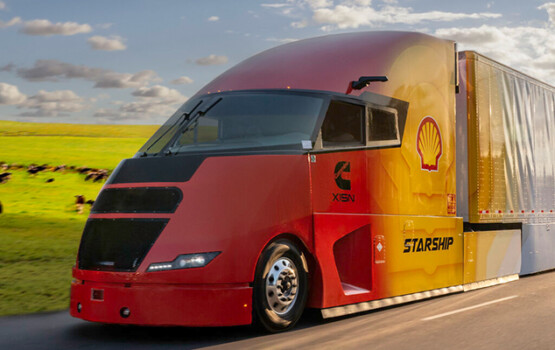Portal for more climate-friendly mobility

Storing energy for the winter
With the demonstration project “Underground Sun Storage”, the large-volume storage of green H2, the energy turnaround is one step closer in Gampern, Upper Austria. In the cross-sector demonstration plant, solar energy is converted into hydrogen by means of electrolysis and has been stored as hydrogen in an underground, natural gas reservoir since April.
 A new era in gas storage is dawning with the injection of green hydrogen in the “Underground Sun Storage” in Rubensdorf. Source: RAG
A new era in gas storage is dawning with the injection of green hydrogen in the “Underground Sun Storage” in Rubensdorf. Source: RAG
With the demonstration project “Underground Sun Storage”, RAG Austria AG, together with other partners, wants to show how gas storage facilities, with their enormous storage volumes, can also play an important role as hydrogen and green energy storage facilities in the energy system of the future and should therefore also be repositioned. Austria in particular sees great potential for this due to its geological conditions. This will also make it possible to decouple renewable energy sources such as wind or solar power from short-term consumption.
“The solar and wind power of the summer months must be made storable and thus brought into the winter when wind is not constant and sun and water do not supply enough energy to cover the increased demand,” explains Markus Mitteregger, CEO of RAG Austria: “In our demonstration plant, we bring 4.2 GWh of summer power into the winter in the form of hydrogen and thus make renewables secure in supply. We map the entire value chain and focus on a perfect interplay between generation, conversion, storage and future use of green energy.”
 Michael Längle (CFO RAG Austria AG), Markus Mitteregger (CEO RAG Austria AG), Thomas Stelzer (Governor of Upper Austria) and Stephan Bauer (Project Manager Green Gas Technologies RAG) at the opening of the USS Rubensdorf 2023 (from left to right). Source: RAG
Michael Längle (CFO RAG Austria AG), Markus Mitteregger (CEO RAG Austria AG), Thomas Stelzer (Governor of Upper Austria) and Stephan Bauer (Project Manager Green Gas Technologies RAG) at the opening of the USS Rubensdorf 2023 (from left to right). Source: RAG
In the geological storage facility in Gampern, Upper Austria, the solar power surplus of around 1000 single-family homes can be stored seasonally in the future. Experts expect a seasonal energy transfer of up to 10 TWh per year to become possible in Austria alone by 2030. “‘Underground Sun Storage’ is the first step in this direction, which must be followed by others,” explains Mitteregger. Under the management of RAG Austria and with partners from industry and science, hydrogen will now be produced in the customised demonstration plant until 2025 and stored underground in a gas reservoir to be used in the region as a material or energy source in the future, or also directly via hydrogen power plants to serve the security of supply with electricity and heat.
 Hardly anything can be seen on the surface of the large-volume storage capacity of the “Underground Sun Storage” in Austria. Source: RAG
Hardly anything can be seen on the surface of the large-volume storage capacity of the “Underground Sun Storage” in Austria. Source: RAG
In addition to the promotion and expansion of the country’s own biogas production, the more consistent use of biogenic residues – throughout Switzerland, for example, 1.5 million tonnes of CO2 emissions could be saved in waste incineration and an additional 360 kWh of energy generated per tonne of biowaste by disposing of it correctly via the green bin – such storage options and so-called power-to-X projects – such as the Empa mobility demonstrator “move” or Limeco’s first industrial power-to-gas plant – help to achieve the net-zero targets. After all, every gram of CO2 that can be saved by using biogas or another gas derived from renewable sources in the mobility, heating or electricity sector counts – and brings everyone closer to the “net zero” goal by 2050.
Through the electrochemical conversion of surplus electricity from renewable sources, not only green hydrogen can be produced as in the example of the Austrian demonstration project, but other gaseous or liquid energy carriers such as synthetic methane or methanol. These can be used cleanly and flexibly in all sectors. The decisive factor here is above all large-volume storage and transportability in an existing – in the case of “Underground Sun Storage” even almost invisible – infrastructure. (pd/jas, 4 July 2023)
Large-scale seasonal storage also possible in Switzerland
Whether geo-methanisation is also suitable for Switzerland as a solution for seasonal storage in a renewable energy system was also investigated in the “Underground Sun Conversion – Flexible Storage”. The final report shows: The storage method works and could also be realised in this country – if desired. What role seasonal storage methods will play in Switzerland’s energy landscape in the future is ultimately a political question, however. More information on the Swiss aspect can also be found at the Federal Office of Energy and in the report in Aqua & Gas.
You might also be interested in

Shell Starship on record hunt
